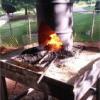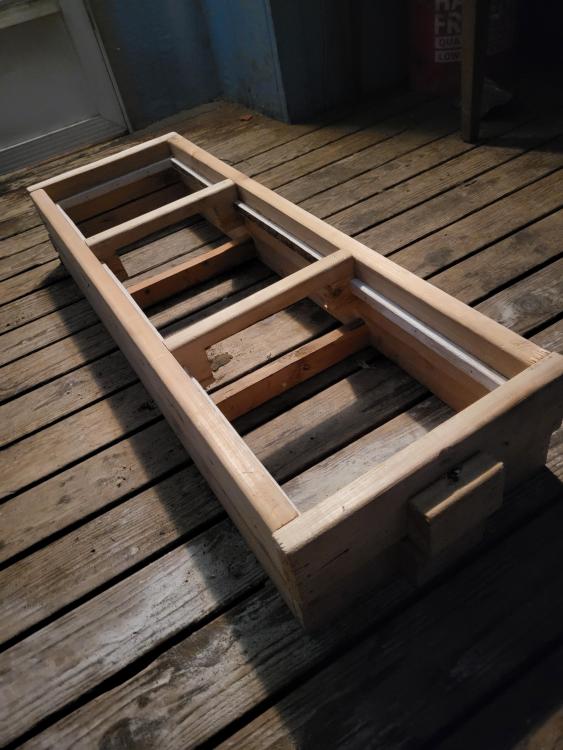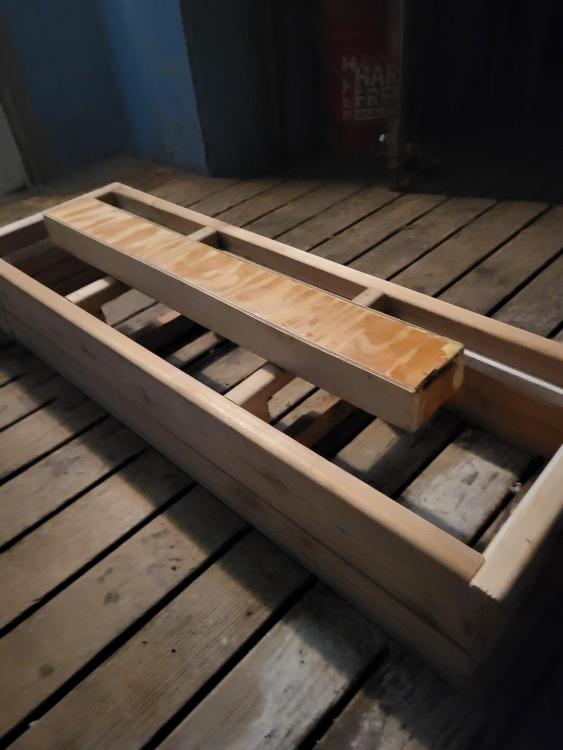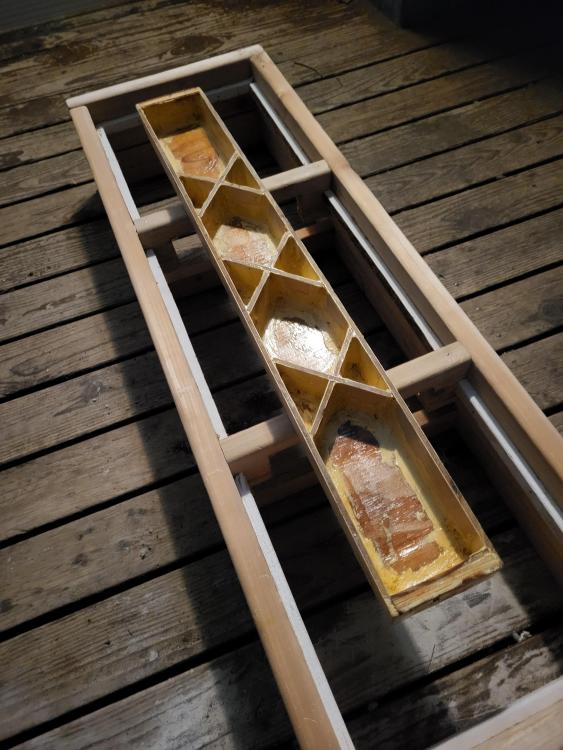-
Posts
1,596 -
Joined
-
Last visited
Content Type
Profiles
Forums
Articles
Gallery
Downloads
Events
Everything posted by Nobody Special
-
Be careful mentioning the Tuatha da Dannan too much, it can draw their attention and bring bad luck. Bad as walking widdershins around a church. I collect a lot of stories, but the best unfamiliar tall tales and stories I know aren't repeatable on a family site. But here's a couple of long sayings for ya in response to "How's it going?" "Fine as frog fur split four ways and tapered on the ends, but I'll be over it by dinnertime." "It's a dog eat dog world and I've got on milkbone boxers". and my personal favorite, "As busy as a three-legged cat covering up scat on a frozen pond". If you're in a hurry, "fair to middlin'" which is a grade of cotton, not a type of weather. Actually, I don't know if you know about telling the bees or tanging them. When you keep bees, you're supposed to tell them about anything important that happens in the house. If you don't share, they either don't stay or don't produce. When the beekeeper or someone in his house dies, someone is appointed to go inform the bees. I've done it. Tanging is the practice of beating pots, pans, or other metal objects to get a swarm to settle. It drives me crazy for the same reason that dowsing does; it's a bunch of superstitious nonsense that shouldn't possibly work, except it does somehow. My grandfather could tang bees right into a box or a trash can. I usually am happy if I can get them to settle somewhere where I don't need a ladder.
-
Anything all blue on the rails is maintenance and not allowed to be removed by anyone but maintenance. "If it's blue, it ain't you". They also use blue lights when occupying a track. You see it on flags, lights, and derails, many of which are portable.
-

What did you do in the shop today?
Nobody Special replied to Mark Ling's topic in Blacksmithing, General Discussion
I didn't pay close enough attention to the eclipse online to see a color change, but normally the coronas exhibit white light only. But...that said, you may have seen colors from the chromosphere, which tend to look sort of pinkish during an eclipse. -

What did you do in the shop today?
Nobody Special replied to Mark Ling's topic in Blacksmithing, General Discussion
Yes, although being in the rain shadow here is like ordering an extra dry water. We only had about 20 percent obscurement anyways and with the clouds out, it just got a little bit dimmer. Most of the year I prefer the weather to be bad. It keeps the tourists and the rich yahoos with second homes away. -
Well, not to go full-UPL, but unless you're contributing to sanctioned Native Alaskan subsistence bowhead whaling, which seems unlikely in Ohio, you might consider trying under the special case considerations from 26 U.S.C Section 170, subsection f, i.e. materials for research purposes, foods, or if you're really feeling your Wheaties, the taxidermy exemption. Depends on how you frame it and what support documentation you can provide. Honestly, I'm surprised they still call it the Alaska Eskimo Whaling Commission; the name is offensive as hell.
-
We used to have them die under the house once in awhile down in Texas, armadillos too. One I can tell you from keeping bees is that you don't want to go seal them in or bug bomb them in the walls or attic. If you seal them in, they tend to chew their way out in interesting places, like inside your living room. If you kill them, the honey ferments, sometimes grows mold, and draws bugs that then lay larva in the comb. Think a large stinky wet space in your ceiling that eventually pops open with fermented goop and bug larva dripping everywhere. Call the nice beekeeper in to take down your walls and then get someone to fix it after.
-

What did you do in the shop today?
Nobody Special replied to Mark Ling's topic in Blacksmithing, General Discussion
It was like every other early April day up here. Today's weather? 120 degrees with rains of frogs? Grey and cloudy, probably rain. The sun is as sackcloth and the moon is as blood? Little light rain - grey and cloudy. MMA fight between the Ice Giants and Aesir while the Fenrir wolf eats the moon and UFOs film it for intergalactic distribution? Never know it from here...grey and cloudy, probably rain. -
Silicon carbide (carborundum) contains well, silica and carbon, and is usually sintered together from powder or pressed to shape, so, I wouldn't be overly surprised if it had black powder on it. The carbide itself will usually be black or kinda dark brownish when rubbed depending on the composition when they made it. Silicon carbide is also about half again as heavy as graphite, but if you don't have a graphite crucible to compare it to, that doesn't help much. Of course, the real problem you have is that many silicon carbide crucibles contain graphite, just as many graphite clay crucibles contain silicon carbide. I dunno, if you use it and it starts coming apart too early, I would lean towards a possible counterfeit...or user error. Or rough handling during shipping. Or the stars are misaligned....
-
I thought the PTSD went away when I started sleeping again about eight months after I got back and I didn't get angry in such a hurry anymore. Whoops. Took a few years of hard drinking to figure out it was still hanging around, p.s. not a great cure. Not saying it wasn't fun trying but would not mash like or subscribe. Army then the Guard, 99 to present, nine in the big Army and 15-ish of it full time. Several of the 35 series (shhh), Leonard Wood, DLI, Goodfellow, Ft. Huachuca a couple of times, S. Korea, Hood (yuck), Eustis for 1-day (they later wrongly reported me AWOL), Little Creek (do NOT eat at the squids' nasty, filthy chow hall!!!), Jackson, Camp Williams twice, JBLM w a side-trip to al-Anbar from 07 to 08 (bloody surge), Ft. Gillem, Clay NGC, and JBLM again the last few years. E-7 and avoiding E-8 like the plague. Perfer et obdura.
-

Casting a Gingery Lathe
Nobody Special replied to Nobody Special's topic in Smelting, Melting, Foundry, and Casting
Good evening, It's got draft, more so on the long sides than the short...think the short sides could have used a hair more. For the falling in, I'm pretty sure I badly screwed up by getting the runner, and especially the risers too close to the pattern. I totally agree about removing the pattern from the mold, but I'm not sure how to go about it cleanly with the way Gingery has the cores sitting on the drag, and considering they're rammed concurrently, almost as an extension of it. Built that way, the tolerances are kinda tight for baking the cores and inserting them. The x-braces are clearly too small and don't have enough draft, which I'm not sure how to solve easily. Possible solutions, a. leave them out altogether and just use thicker braces going straight across, sanded to give them a slight draft, b. use two, wider X-braces to make the cavities and thus the cores larger (and thus come out easier), or c. put no braces at all on the pattern so it makes one giant core, then attempt to cut "X"s into it without collapsing the core. A. is probably the simplest. Or I could just go ahead and do one the tried-and-true Gingery method, but heck, I can't even make mac and cheese anymore without playing with the recipe. To speak to Leos's question, two reasons. Part of it is the challenge of doing things the bloody hard way and developing a skill, in this case casting. The reading I've been doing has been giving me a much better understanding of metallurgy and it is a fun, if sometimes exasperating challenge, not dissimilar to other craftwork like blacksmithing. I could crank out a functional wood lathe at various levels between a few minutes and a few hours, and I could work half a day and pick up a far better metal lathe than I can manufacture, used. The difficulty level goes down when I listen to good advice, which I don't always, but a dramatic failure is fun too, if not always at the time. The other reason is that the reason I'm casting a lathe to begin with is that my wife asked me to teach her to cast metal, which is hard to do from fabricating (she already welds better than me, if her old neck injury lets her). If she can pick up half of what goes into this, it will be a very nice foundation for whatever else she wants to play with. -

Casting a Gingery Lathe
Nobody Special replied to Nobody Special's topic in Smelting, Melting, Foundry, and Casting
Failure is always an option in experimentation, I just wish it wasn't so frequently the main option. Just tried to make the mold for the bed for the third time and failed the third time. Gingery had a pretty simple, but lousy system for feeding metal into the mold; he put a big honking sprue right on top of the pattern. That way tends to cause turbulence, poor feeding, and shrinkage that creates a lot of extra finish work. In my infinite wisdom, I thought I'd save myself a lot of finish work and put a regular feed system in with a sprue, runner, two risers, and four gates. Looked fantastic, but because the flask was so narrow to keep the weight down, I put it too close to the pattern and it was making a weak spot in the mold, with the end result that part fell in by one of the risers...three times, dang it. Got it figured now, longer gates so everything is further from the pattern. The other problem I'm a little more stuck on. Gingery has two or three braces going straight across the bottom. The pattern is put in the cope, which is filled, right side up, the whole thing is flipped over, the drag placed on it upside down, and the cores in the bottom of the pattern get made when the drag gets rammed. The last part of his process is flipping the whole thing over, lifting the cope off of the pattern which is left setting on the drag, then pulling the pattern off of the cores, which are left setting on top of the drag. That's bloody brilliant, but I found out in a hurry that when you try it with X shaped braces, to cut down on the Gingery's tendency to have the bed want to twist, the cores get stuck in the bottom. Not a little stuck, like I have to dig the smaller ones out with a pocketknife. I'm thinking I may have to rebuild the pattern from scratch and use either do it Gingery's way with thicker braces, or with much longer "X"s to create bigger spaces. Open to suggestions though. -

So I want to melt/smelt some brass...
Nobody Special replied to Apocalypse's topic in Smelting, Melting, Foundry, and Casting
What's viable now isn't what might be viable if the world markets or the technology shifts even a little. Think the last US tin production shut down in 1993, but there's tons of it in Alaska, and I think there's a fairly big casserite deposit in eastern Washington and Idaho for one. But heck, used to be low grade ores weren't bothering with, but the last few decades, the Bingham Canyon Mine in Utah shipped slurry in a two-percent copper ore something like thirty miles through pipes to a refinery at the north end of Salt Lake profitably. Really cool set up too and you can go see them float the copper on surfactant bubbles and electrolytically deposit it into big flat ingots. Huge smokestacks that seem to give off a tiny puff of steam about once an hour. Pewter does seem to vary, but it also seems to depend on where it's made. That would be a problem buying it off the scrap heap, but I get a lot of mine in thrift stores, where you can try to track down the maker from the markings and go from there. Most Brittania metal is fairly consistent, as is a lot of European pewter, which is almost the same stuff. Amercian pewter is hit and miss, and Mexican pewter mostly isn't. It's aluminum-ish. A lot of the East Asian stuff is almost pure tin. -

So I want to melt/smelt some brass...
Nobody Special replied to Apocalypse's topic in Smelting, Melting, Foundry, and Casting
I second the motion on fume fever sucking. Brass isn't usually forgeable, except for the stuff that is. Also, also, when you add the metals, you have to allow for loss to evaporation. With brass, and adding zinc just before pouring, it's usually about a five percent loss, or so sayeth Metals in the Service of Man. I forget how much tin ya lose with bronze, but you can't add it to copper shortly before casting the same way as adding zinc to make brass; it'll be too cold and may oxidize to boot. Not all alloys are easily reached in one melt either; with some metals sometimes you have to make intermediate hardening alloys before the final melt. The more I learn about casting, the more I can't believe that I first did it because I thought it would be easier and safer than forging. -

Show me your blacksmith pets
Nobody Special replied to Glenn's topic in Blacksmithing, General Discussion
Garryowen, boss. I'll tend to take an officer that's at least seen the elephant, and for preference gimme a mustang if you can find one. Too many slick-sleeves out there at the top of things. My first thought on that quad-50 was "Holy crap, they're using an anti-aircraft for anti-personnel. There won't be enough Ziploc baggies in the world." For the Mothman, my condolences. Hard to lose the good ones. -

Casting a Gingery Lathe
Nobody Special replied to Nobody Special's topic in Smelting, Melting, Foundry, and Casting
So, I ain't dead yet. Just been busy playing Army and helping a friend move. Between yesterday and today, I got the pattern made for the hardest casting, the bed, and made a flask for it. I'm still figuring it out a little, but there are a few changes from Gingery's design, mostly the dimensions and the x-braces. It's a bit taller, a bit wider, and parts are a bit thicker. Also left room on the bottom for a wider foot under the headstock. Doing the fillets was much more of a pain than I anticipated, largely due to the bloody x-braces, but if the braces cut twisting/torsion, they'll be worth it. If everything works out, hope to cut a molding board and pour tomorrow evening (Changing that a bit too. Too much clean-up with a pop gate straight in the middle and no risers). -
Suit yourself - we had pecan and dutch apple. It might be silly, but there's pi-e, and that makes all the difference.
-
This also depends on what you call a bug, and for that matter what you call a lung. If you include arachnids, then you get book lungs, at least for some of them. Book lungs don't work like people lungs though, they're basically a bunch of folds that increase the amount of surface area the arachnid can absorb oxygen through without having to be moved. Kind of like an air-cooled Volkswagen, surface area matters. They probably evolved from specialized gills, although some of the smaller arachnids, like mites, breathe in pretty much the same fashion as insects. And while I'm thinking about it, keeping spiders in your trash would probably cut down on the fruit flies, but I'm not sure that it's practical, although it would be fun to refer to the kitchen trash can as Cirith Ungol.
-
Does this mean, Frosty that you only celebrate Pi day on March 14 at 03:49 a.m. (i.e. 229 minutes or .15926535, etc of a 1440 minute day)?
-
Regarding ghosts, I'll apply Granny Weatherwax's advice on gods in the Discworld. I ain't saying they ain't real, I just don't you should go around encouraging them by believing in them.
-

Work-hardening a sickle question
Nobody Special replied to SubterraneanFireForge's topic in Cold Worked Iron and Steel
Regarding sickles and scythes, at least traditionally they were sharpened constantly through the use of whetstones and peening the blade's edge way thinner than feels comfortable on a small stake anvil. It's a righteous pain to do until you get used to it, but in the right hands (i.e. not mine) they cut insanely fast. This has changed somewhat in America, where the tradition is to have a thicker spine and sometimes the beveled part of the blade. The videos of cutting grass with a European style scythe are hypnotic and almost feel fake, especially if you're watching one where someone almost keeps up with a modern farm machine. -
As I'm given to understand, rampage first, booze, then a little more rampage before "Mongo just pawn in great game of life" and going Goodnight Irene. Slept it off and was good to go after. Since we're in a curio section and on weird history, elephants have an absolutely insane history in America. They were frequently shot in parades after being advertised as having skin that was bulletproof, and in at least one instance, one was hanged after killing a freshly recruited hobo handler that beat her too much. They hung it from a gantry hook on a railroad car, the chain used for the travesty broke and it displaced a hip, then they did it again, buried it, and dug it up again and staged a photo of the event for the papers the next day. You can find it easily using the googles. Then there was the one that was sentenced to death and electrocuted on the bridge to Coney Island...they made copper shoes for it just to ensure that it would get sufficient grounding. There was a great microhistory on the whole subject called Elephants in America. https://www.google.com/imgres?imgurl=https%3A%2F%2Fmedia.npr.org%2Fassets%2Fimg%2F2019%2F05%2F13%2F025_027_07_elephant009_custom-cece01e7e9790ab2cfdf78f394c834d32c8939a6.jpg&tbnid=gu2wDhUKVEhyoM&vet=12ahUKEwigxN-ugOGEAxWMPzQIHVvDBk0QMygAegQIARBK..i&imgrefurl=https%3A%2F%2Fwww.npr.org%2F2019%2F05%2F15%2F722236763%2Fthe-town-that-hanged-an-elephant-is-now-working-to-save-them&docid=4L9jlUBx5XsnIM&w=2950&h=4121&q=elephant hanged&ved=2ahUKEwigxN-ugOGEAxWMPzQIHVvDBk0QMygAegQIARBK
-
I don't have a lot to add to the Bigfoot arguments, living in the middle of the supposed territory, but I saw a sundog once, and there's a town near me that had an elephant go on a drunken rampage, Tusko, in Sedro-Wolley. Handler got it off a circus and would tour it up and down the coast, come and see it for two bits. Settled in for the winter and took it out for a walk when it decided to go walkabout. Knocked at least one house of its foundations, smashed a few cars, and drank an entire Prohibition-era tank of sour mash. No I told you all that because shiny-keys, squirrel, gestalt!!! and I came in to point out that Doc Nichols of the whiteboard fame used to hang out on here and I believe still has old posts if you can find them.



